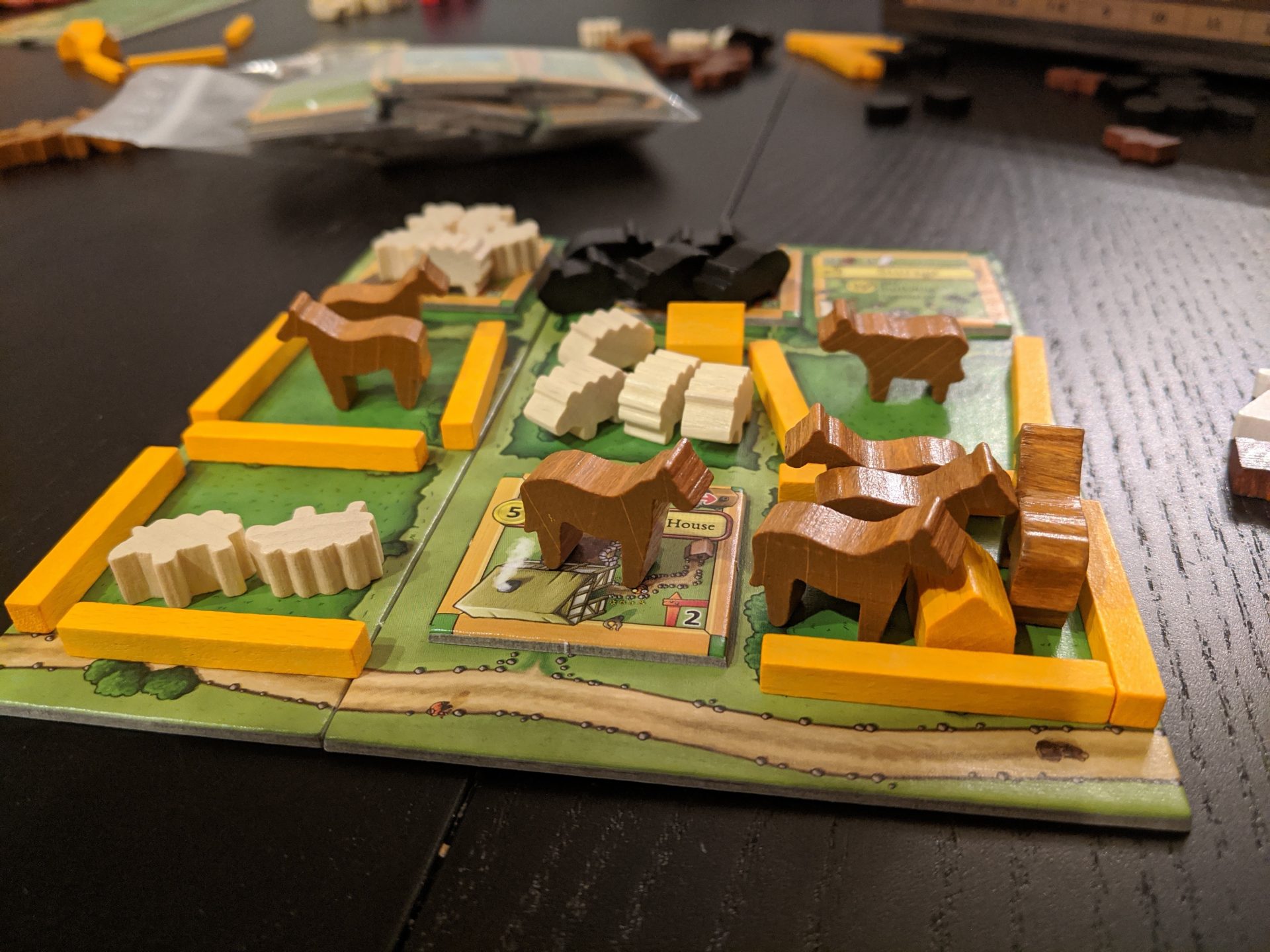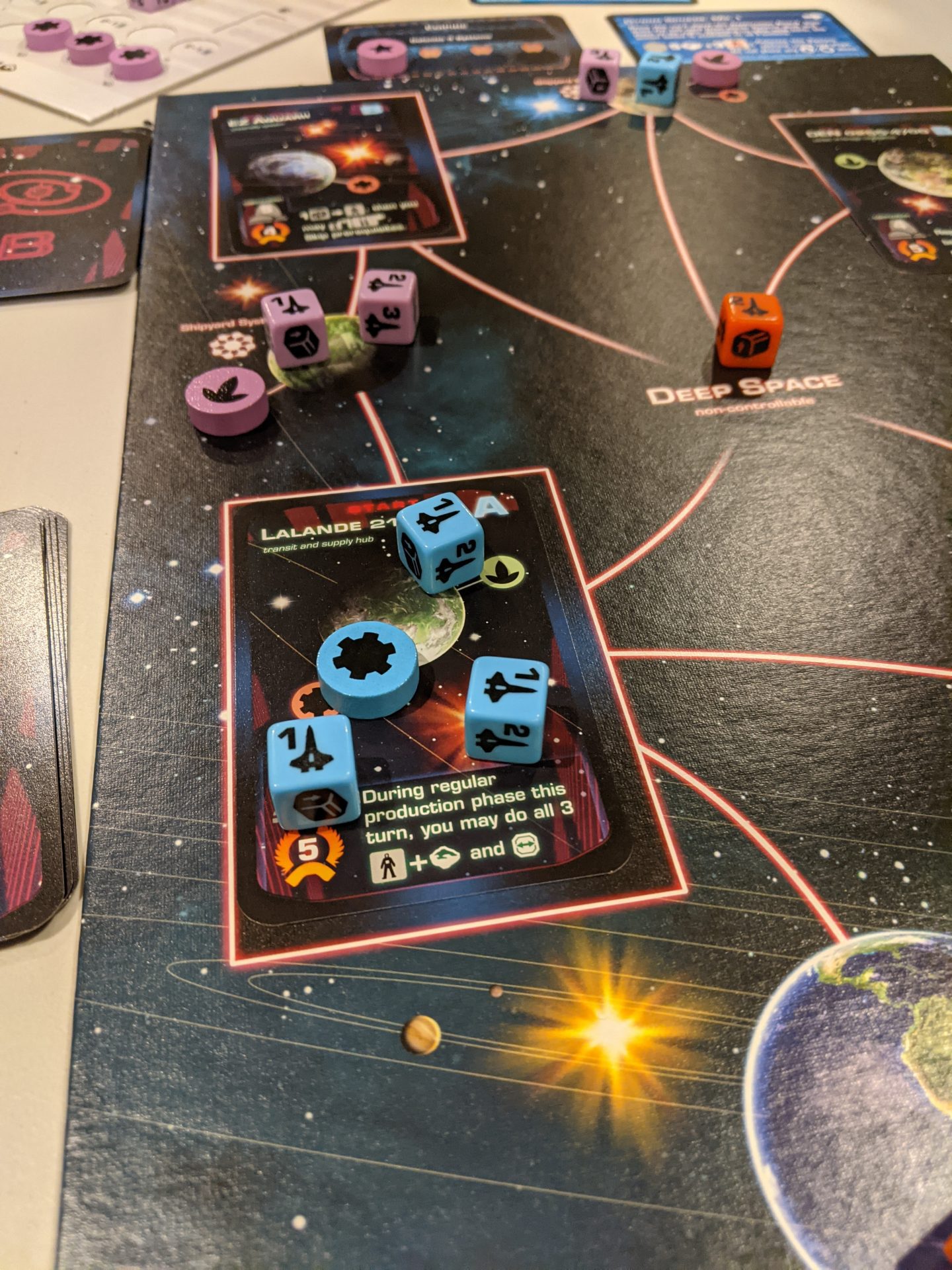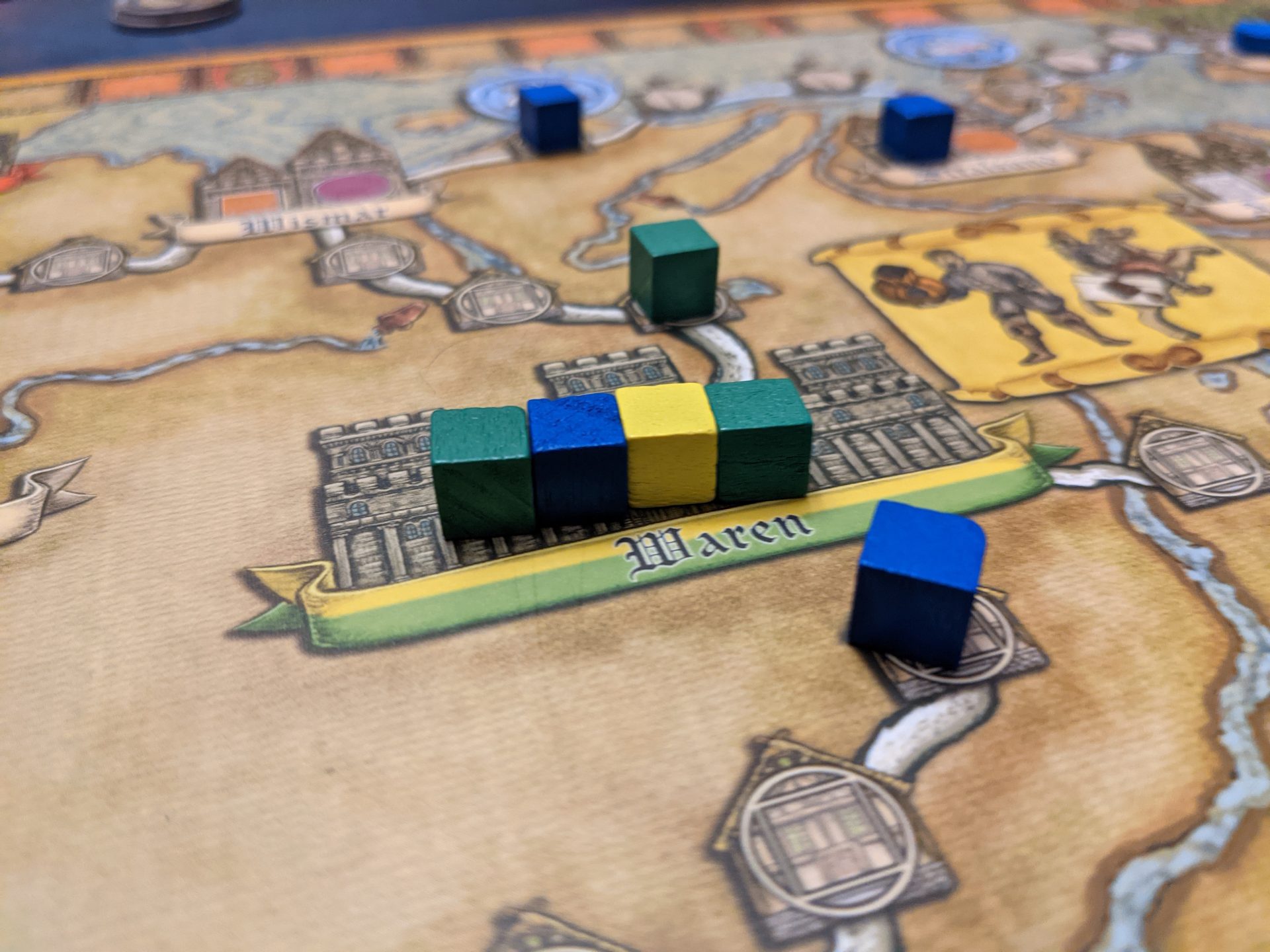We were winding down our game of Alma Mater, a fine game by the designers of Lorenzo il Magnifico and Coimbra; unlike many other games, the vast majority of scoring in Alma Mater takes place only at the end.
And as we added up scores, I could tell that my buddy Joel and I were on a collision course for a score somewhere in the low-to-mid 90s.
We each ended with 96 points. Although we had played Alma Mater a couple of times before, we were not familiar with the rules around ties, so we whipped out the rulebook. Given the theme of the game—players are tasked with building a successful university by recruiting students, hiring the best professors, and completing research to score bonuses throughout gameplay—I assumed one of these conditions would likely be the tiebreaker.
And here’s what the manual says: In the case of a tie, the tied player who has the highest priority in turn order, determined at the end of round 6, is the winner.
There is a space on the board in Alma Mater where you can send your meeples (known as masters) to gather a few coins but, like Lorenzo il Magnifico, going to that space before another player also ensures you will go first in future rounds.
Of course, you would never use that space only to plan for an eventual tiebreaker scenario, so tying a win condition to something so arbitrary lit me on fire.
“I’m surprised that the tiebreaker wasn’t the research track,” said Joel. Before opening the manual, I also assumed standing on the research track would be the tiebreaker. The research track was a much better assessment of something important tied to gameplay (in addition to granting bonuses for each major step on the research track, the leader of that track also gets the benefit of knowing their books are the most valuable during gameplay for attracting the best student tiles).
Oh, and there’s one other major miss with the Alma Mater tiebreaker: what if no player went to the income space during the final round? If you’ve managed your money well late in a game of Alma Mater, you would not use the income space. And like me…you would have lost for your stellar planning.
Tiebreakers like this one, sadly, are common in the game industry. Rulebook writing is generally excellent. Quality components? I’m finding games now, like Maglev Metro, Cryo and more, that are excellent examples of retail versions of games packaged with some of the highest quality bits in the business. Many games even paste a theme on that really does fit the gameplay, instead of the “themeless Euro” ideas of the recent past.
But tiebreakers are a complete crapshoot. Why is that?

Come for the Gameplay (Just Don’t Stay If There’s a Tie Score)
In my humble opinion, the best tiebreakers in the hobby don’t require any advance planning. They are a natural product of gameplay, where a player is doing their best to win without needing a tiebreaker in the first place. Makes sense, right?
Running through my collection of about 75 games, the tiebreakers really run the gamut. Some of them are amazing, thematic, and fit the gameplay, while others make you want to toss a game with a tight finish out the window.
Some fit right in the middle. Agricola: All Creatures Big and Small, for example. If the game is tied after the eighth round, whoever went second in the first round is the winner. I like this, but then I thought about it some more: going first is just a matter of luck, since my wife and I use Chwazi or flip a coin to see who goes first.
Should that determine the winner?
I have a few point salad scoring games, like The Castles of Burgundy, Pulsar 2849, and the like. Games like that may or may not have good tiebreaker rules, but frankly if I’m playing a game like The Networks where I might score 260 points, it’s going to be rare when we have a tiebreaker scenario anyway. I have met people who “house rule” tiebreakers in these cases: if we both score 194 points in a game, let’s just shake hands and call it a day!

Some tiebreakers that make sense
Cryo hit my table for the first time recently and it seems like scoring will be low enough to warrant a good tiebreaker rule. The story for Cryo: players are factions working to save crew pods from a crashed ship and move them into caverns below the surface of an uninhabitable ice planet.
While you certainly have to find other ways to score points in Cryo—mission cards, an area control mechanic, points for upgrades on your player board, etc.—the tiebreaker makes complete sense: whoever has moved the most crew pods from the surface of the planet to the caverns break ties. And if those players are still tied, they share the victory; I’m OK with this, since the mission was to save the lives of your crew anyway.
Tiny Towns is a favorite in my collection; it always works as a filler when I have 4-6 players (it plays less, but it’s fun as a larger group party game). The goal is to collect cubes to place buildings based on public blueprints available to all players. The tiebreaker: whoever was the “Master Builder” (each turn one player selects the cube color that all players must place on their player mat) the least is the winner. Second tiebreaker: the player with the fewest remaining empty squares wins. Both of these reward efficiency in a game about making the most out of your limited mat space and the choices made by the Master Builder each turn.
A few other games in my collection have very reasonable tiebreaker conditions:
- San Juan: most cards left over in your hand and on your production buildings (cards each cost a number of cards spent from your hand, so this correctly rewards always having a big hand)
- Lost Ruins of Arnak: whoever got to the Lost Temple first on the research track breaks ties (research is ultimately the key in this game, and this acknowledges that nicely)
- Sushi Go! Party: most puddings (dessert should be the tiebreaker!)
- Vinhos Deluxe (Special Vintage 2016 rules): most wine barrels in the export area, then most money, in a game about shipping wine for points and cash
- Luxor: the edge here goes to the person who got the more valuable sarcophagus in this archaeological race to the tomb game
- The Taverns of Tiefenthal: leftover beer and money, in a game which prioritizes beer and money
Many of the games in my collection apparently get it right, then. But, sadly, not all of them!!

The negatives? The tiebreakers that just don’t make any sense
Oh wow; where to begin!
Let’s start with Dwellings of Eldervale. Across my three plays, scoring does bleed into point salad territory, but I’ve always found games to be really tight. During gameplay you are urged to gather as many resources as you can to acquire cards that can help with your engine and to build dwellings on the game board throughout the game.
But here’s the tiebreaker: most leftover resources.
As someone who has now lost a game of Dwellings of Eldervale this way, it was a strange way to wallow in defeat. The goal of this game is literally to build dwellings on Eldervale. Shouldn’t THAT be the tiebreaker? How about whoever defeated the most monsters? Or whoever triggered the endgame (one way to do this is to build all six of your dwellings first)?
But instead, it came down to the guy who couldn’t use many of his cards (those are considered resources in this game), swords and tools after counting up our scores. It still ranks as one of the few times I was angry while playing games during the pandemic, since I was usually so happy to be playing games at all.
(That said, please, please, please play Dwellings of Eldervale; it was the best game I played last year and it’s a blast to roll dice and defeat monsters and other players. Plus, those miniatures!!)
How about the tiebreaker for Concordia? This one really lit a fuse:
“A tie is won by the player owning PRÆFECTUS MAGNUS, or by the tied player who would receive him next in the course of the game.”
WHAT? If you’ve played Concordia, you know that control of this card is not an indicator of who planned out their strategy the best. Many times, you are the holder of this card and take cash instead of double production, so you might have the card solely for that reason. Further, you would NEVER IN A MILLION YEARS plan your strategy around ending the game with it, just in case you were to end a game where the score could end in triple digits in a tie.
I asked the Meeple Mountain team for their thoughts on tiebreakers; the tiebreaker rule for Arboretum came up a couple of times. Tied players are asked to go plant a tree (in the real world, not the game world), then check back in five years to see whose tree has grown the tallest, and then they can determine the winner of their game.
Cute. If anything, at least that game’s design team is using trees as a theme to…not answer the question of who should be declared the winner. And for a knife fight like Arboretum—I am still suffering light amounts of PTSD based on my initial play, when I finished with maybe three points after getting ripped apart by those around the table—it’s amusing that a cutthroat card game has a tiebreaker tied to environmental sustainability!

Why do games need to have four levels of tiebreakers?
I get it: some people really, really, really like to win. I would argue that a few people I play with NEED to win in order to feel good about the experience.
Certainly, I would rather win than lose, but losing doesn’t take away from the overall experience if the game is good. (Trust me: losing a game of Crash Octopus is not really losing. Just sitting at the table is a hoot!) But when game designers are working out tiebreaker rules, they have one audience in mind: people who need to win to survive.
Many games I have played feature three tiebreakers. One which I played recently, Dune: Imperium, has four tiebreakers: spice, Solari, water and garrisoned troops. (In a game and accompanying book series which relies so heavily on the importance of spice, shouldn’t spice be enough??)
Another one, Beyond the Sun—my number one game for 2021—also has three tiebreakers, but the first one would have been enough: whoever has the best production engine (least production discs remaining on their player board) would have absolutely been perfect.
And many of my games have that most begrudging of begrudging lines written in the rules:
“And if multiple players are STILL tied, then these players rejoice in their shared victory.”
Again, I get it: some people need to know that they were the very best at the game you are playing. Or something. But I’m older now, and I know how fortunate I am to even be able to participate in the hobby, so I’ll take a shared victory eight days a week (and twice on Sundays). Others may disagree, so having multilayer tiebreaker win conditions might be needed.
On the flipside, I do think games require a tiebreaker condition if scoring will be low, tight, or both. I recently reviewed a game called Supernova and to my surprise, there were no tiebreaker rules featured in the rulebook. In my plays of Supernova, no player even had more than 12 points. In our second game, two players ended with the exact same score. It was strange that this scenario had not presented itself to the game’s design team because Supernova is such a low-scoring affair.
So while I don’t need four or five conditions to determine a winner beyond points scored, addressing this reality in a game where scores are tight is worth doing. Someone who is hyper-competitive is eventually going to play your game!!

So, What’s the Perfect Tiebreaker?
I’m sure some of you would say that the perfect tiebreaker is none at all; I like the idea that any sort of race game where one person gets to the end of the road first should just flat out win. And I’m like that too; let’s reward the person that had the best gameplan in a strategy game, or who maybe was just the luckiest in a game where they had to roll dice the entire time.
Wildlands is such a game. Super tight skirmish game designed by Martin Wallace (Brass: Lancashire, Automobile, Age of Steam, and many other titles), where the first player to score five points wins. And the way the game plays, it’s always close, with the ability to swoop in during another person’s turn with the Interrupt ability on certain cards to snare victory away from another player.
Some games, particularly point salads like Maracaibo, don’t have a tiebreaker. If you end the game with tie scores, that’s a miracle in and of itself so all tied players share the victory.
The best tiebreaker of a game in my collection is Hansa Teutonica by a country mile. In Hansa Teutonica, players work as traders in Ye Olde Times to set up trade routes and work efficiently to score points off of those routes while creating a network over a vast amount of territory.
The tiebreaker in Hansa Teutonica: whoever has developed their Actions ability the least is the winner. It correctly rewards efficiency to determine who wins the game.
Why can’t all games have a tiebreaker this good?











Add Comment